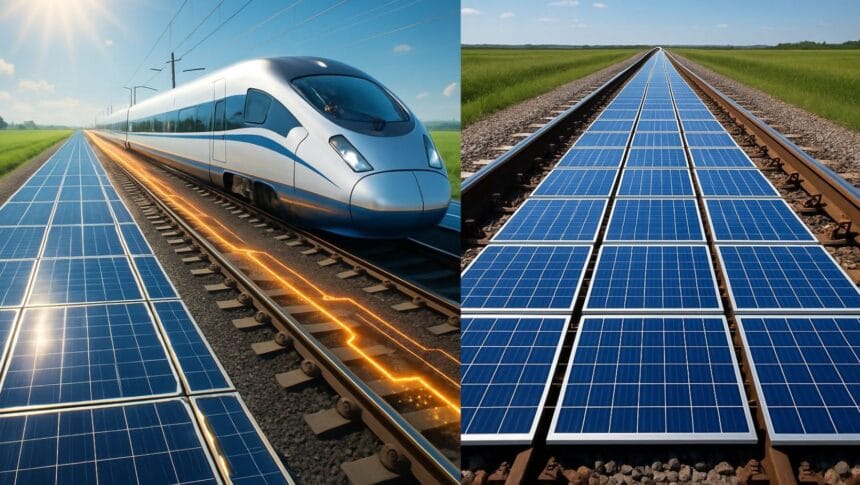Solar Railway Tracks
The railway industry, once a symbol of the industrial revolution, is now at the forefront of a sustainable revolution. Among the innovations leading this change is the concept of Solar Railway Tracks a transformative technology that merges transportation infrastructure with renewable energy. As climate change and energy concerns grow, the need for smarter, cleaner, and more efficient railway systems has never been greater.
This article will explore how solar railway tracks work, the benefits they offer, their role in de carbonizing transport, and why they are set to become a cornerstone in global green infrastructure.

What Are Solar Railway Tracks?
Solar railway tracks are traditional train tracks enhanced with integrated solar panels, or flanked by solar modules alongside the railway infrastructure. These systems are designed to harness solar energy — converting sunlight into electricity to power various aspects of rail operations.
Rather than depending solely on grid electricity, which often originates from fossil fuels, railway companies can now generate their own clean power. This energy can support signaling systems, lighting, stations, and even propulsion in fully electric railways.
There are two primary designs for solar railway systems:
- Track-Side Solar Panels: Panels are installed alongside tracks, in open spaces, or over station rooftops.
- On-Track Solar Integration: Photovoltaic (PV) materials are embedded directly onto or between railway sleepers (ties) or rail ballast, making direct use of the space within the track area.

How Do Solar Railway Tracks Work?
The technology uses photovoltaic cells, which convert sunlight into electricity. These cells are mounted either directly on the infrastructure or close by. The generated electricity is then:
- Fed into the grid to supplement national energy supply
- Stored in batteries for later use during peak demand or cloudy conditions
- Used instantly to operate nearby systems such as signals, lighting, or train systems
Advanced solar railway systems also incorporate smart energy management platforms. These platforms monitor generation levels, predict usage, and optimize power distribution for maximum efficiency.
Key Benefits of Solar Railway Tracks
1. Reduced Carbon Emissions
One of the most significant benefits of solar railway tracks is their contribution to carbon neutrality. Railways already offer a lower carbon footprint compared to road and air transport. Adding solar power amplifies this advantage.
2. Operational Cost Savings
Electricity is a major operating cost in modern railway systems. Generating solar energy on-site can significantly reduce dependency on external power providers, cutting down electricity bills and offering long-term savings.
3. Improved Energy Security
Solar railway tracks offer a decentralized power solution. Even in remote or rural areas, trains and stations can maintain operations during power outages or supply disruptions.
4. Optimized Use of Space
Rail corridors span thousands of kilometers and often lie unused for anything other than train movement. Installing solar panels makes productive use of this real estate, especially in regions with high solar irradiance.
5. Support for Electrification Goals
Countries worldwide are investing in railway electrification as a means to reduce reliance on diesel locomotives. Solar railway tracks provide a natural pairing, supporting electric trains with clean, renewable power.
Global Examples and Innovations
India
The Indian Railways has launched multiple solar-powered stations and installed panels on trains and trackside areas. It aims to become a net-zero carbon emitter by 2030, and solar infrastructure is central to this goal.
United Kingdom
UK-based startup Riding Sunbeams has pioneered track-side solar installations that directly power railway traction systems. Their pilot projects show the feasibility of feeding solar power directly into DC-powered lines.
Germany
In Germany, solar sound barriers along train tracks are becoming popular. These panels double as noise-reduction walls and energy generators, blending sustainability with practicality.
Challenges to Overcome
While the promise of solar railway tracks is enormous, several challenges must be addressed:
- Durability: Panels placed directly on or near tracks need to withstand vibrations, debris, and extreme weather.
- Efficiency: Railways are often shaded by nearby vegetation or urban structures, which can reduce solar exposure.
- Cost: Initial investment in infrastructure and technology can be high, though this is expected to decrease with scale and innovation.
- Maintenance: Regular cleaning and servicing of solar modules, especially in dusty or industrial regions, is essential to maintain performance.
Despite these challenges, technological advancements are rapidly improving durability and reducing costs.

The Future of Solar Railways
The integration of solar power into rail systems isn’t just a trend — it’s a necessity for building future-proof transport networks. As urban populations grow and demand for clean transportation rises, solar-powered railways offer a path forward that balances efficiency, cost, and environmental responsibility.
Looking ahead, we can expect:
- Hybrid systems combining solar, wind, and battery storage
- AI-powered energy grids for real-time monitoring and smart distribution
- Solar trains capable of generating and storing their own electricity
- Cross-sector partnerships between governments, rail companies, and tech innovators
Why This Matters to You
Whether you’re a commuter, an environmentalist, a policymaker, or simply someone interested in the future of transportation, solar railway tracks affect us all. They are more than just a technological feat — they symbolize a shift toward cleaner, smarter, and more sustainable mobility.
By supporting solar railway initiatives, we invest in a future with:
- Less air pollution
- Lower carbon emissions
- More reliable transportation systems
- Energy independence
Final Thoughts
Solar Railway Tracks are more than a fusion of solar energy and rail transport — they are a vision of sustainability in motion. By harnessing the sun to power the world’s most efficient form of land transport, we take a powerful step toward decarbonization and smarter infrastructure.
In a world where transportation accounts for a major chunk of global emissions, every mile powered by the sun is a mile closer to a greener planet.
Read More: The Future of Smart Speed Bump
Read More: High-Performance Concrete Build Business Case Value
